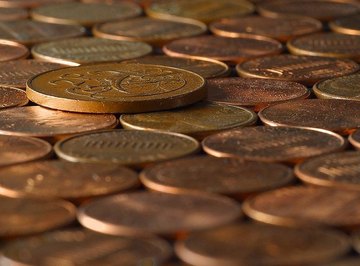
Corrosion
Like all materials made from copper, pennies are subject to corrosion. Though copper is resistant to most types of materials, it tends to corrode when exposed to oxygen, sulfur or ammonia. This means that a penny will corrode when simply exposed to oxygen in the air we breathe every day. The copper reacts with oxygen molecules in a process known as oxidation. After oxidation has taken place, the byproduct of this reaction leaves a layer of green film on the surface of the penny. This green film is sometimes called patina and is considered a desirable effect when it develops on certain other copper products. The scientific term for this green layer of corrosion is copper-hydroxide-carbonate.
Different Colors of a Penny
Prior to 1982, pennies were made from 95 percent copper, with about 5 percent zinc content. As the price of copper rose, the cost of this material became too expensive for penny production. To keep the same look for the penny at a cheaper price, the formula was changed so that 95 percent of the penny was zinc, and about 5 percent was made from copper. This difference in composition helps to partially explain the different colors a corroded penny can take. Because zinc tends to corrode more quickly than copper, newer pennies tend to form darker green or black layers as they corrode. The change from green to black is a sign of progressive corrosion. It occurs when the copper-hydroxide-carbonate on the penny's surface reacts further with oxygen and moisture in the air to form copper sulfides. Older pennies may never reach this level of corrosion and thus maintain a lighter green coat.
Silver Pennies
While the penny is characterized by its copper hue, some people may stumble across a silver penny at some point in their lifetimes. There are several factors that you may be able to attribute to this silver finish. During WWII, copper supplies were rationed for war supplies. During this time, pennies were made from steel and zinc, giving them a silvery color that was similar to that of other coins. These coins are dated with the year 1943 and are considered collector's items, though they are not exceptionally rare.
A silver coin with a later date may have been caused by one of two methods. First, a popular science experiment for chemistry students is to use a penny to explain how electroplating works. As part of this experiment, students dip copper pennies into zinc, which covers the copper and gives the penny a shiny silver color. It is also possible that a regular copper penny was dipped in acid, which removes the thin copper coating, leaving only the silver-hued zinc core.
References
About the Author
Emily Beach works in the commercial construction industry in Maryland. She received her LEED accreditation from the U.S. Green Building Council in 2008 and is in the process of working towards an Architectural Hardware Consultant certification from the Door and Hardware Institute. She received a bachelor's degree in economics and management from Goucher College in Towson, Maryland.
Photo Credits
Wiki Commons
